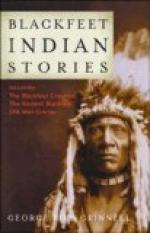Presently one of the littlest ducks while dancing could not feel any one on either side of him, and he opened his eyes and looked, and saw what Old Man was doing. He cried out to the rest, “Run, run, Old Man is killing us”; and all the other ducks flew away, but ever since that time that little duck’s eyes have been red. It is the horned grebe.
Old Man took the ducks and went off a little way and built a fire and hung some of the ducks up in front of it to roast, and after the fire was burning well, he swept away the ashes and buried some of the ducks in the ground and again swept back the fire over them. Then he lay down to wait for the birds to cook, and while they were cooking he fell asleep.
While he slept a coyote came sneaking along and saw Old Man sleeping there, and the ducks roasting by the fire. Very quietly he crept up to the fire and took the ducks one by one and ate them. Not one was left. Pretty soon he found those that were roasting under the fire, and dug them out, and opening them, ate the meat from the inside of the skin and filled each one with ashes and buried them all again. Then he went away.
Pretty soon Old Man woke up and saw that his ducks were gone, and when he saw the tracks about the fire, he knew that the coyote had taken them.
“It was lucky,” said Old Man, “that I put some of those to roast under the fire.” He dug them up from under the ashes, but when he took a big bite from one, his mouth and face were full of ashes.
THE ANCIENT BLACKFEET
Long, long ago, before our fathers or grandfathers were born, before the white people knew anything about the western half of North America, the Indians who told these stories lived on the Western plains. To the west of their home rose high mountains, black with pine-trees on their lower slopes and capped with snow, but their tents were pitched on the rolling prairie. For a little while in spring this prairie was green and dotted with flowers, but for most of the year it stretched away brown and bare, north, east, and south, farther than one could see.
On these plains were many kinds of wild animals. Sometimes the prairie was crowded with herds of black buffalo running in fear; or, again, the herds, unfrightened, fed scattered out; so that the hills far and near were dotted with their dark forms. Among the buffalo were yellow and white antelope—many of them—graceful and swift of foot. Feeding on the high prairie or going down into the wooded river valleys to drink were herds of elk, while the willow thickets, the brushy ravines, and the lower timbered foot-hills sheltered deer. The naked Bad Lands, the rocky slopes of the mountains, and the tall buttes that often rise above the level prairie were the refuge of the mountain sheep, which in those days, like all the other grass eaters of the region, grazed on the prairie and sought the more broken, higher country only when alarmed or when they wished to rest.




